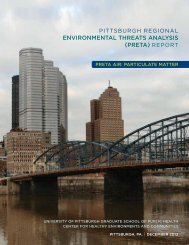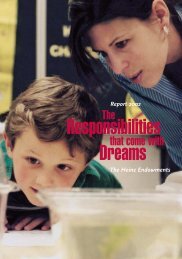View PDF - Heinz Endowments
View PDF - Heinz Endowments
View PDF - Heinz Endowments
You also want an ePaper? Increase the reach of your titles
YUMPU automatically turns print PDFs into web optimized ePapers that Google loves.
of the agencies surveyed said sufficient funding was difficult to obtain to provide the physical and<br />
material resources the.y felt were needed and to hire and maintain staff. Avariety of gõvêrnment and<br />
p.n]3te funding is available but not used to the fullest extent because agencies a.eïnaùare of its availability<br />
or.howto apply and because much funding is restricted to ceriain types of organizations (e.g.,<br />
public schools), specific types of children, or pariicular purposes.<br />
' I.ow-income families. Full fees a.t.r1Teg-u]a-ted center-based programs would cost approximately<br />
$2'0-00 per year for only the first child, which i! !o.o ]qge<br />
a propo-rtion of total inconió for an entíylevel<br />
wage earner. Even families fiom the GAPS initiative (an employment retention program foi<br />
Allegheny County welfare recipients) receiving subsidies paid an áveiage of $ I . I I pef hour or<br />
$1,110 per year for only one child (many have more than õne child).<br />
Further, low-income families face several special difficulties affording nonschool-hour services. For<br />
instance, the working poor are provided government subsidies only afler families below lBSVo of<br />
poverty are served and thus have no stable source ofsubsidized support. Also, future plans are to only<br />
recommend license.d and regulated services to parents eligible for iùbsidies, which represent only a<br />
small percenlage of the available options. In addition, etlliUitity for subsidies for individual families<br />
can change if employment status changes, meaning that sõme lów-income families are on-off-and-onagain<br />
in eligibility for subsidies, which representsã problem for both parent and agency. Clearly,<br />
nonschool-hour câre is too much for low-income families to pay and not enough tõ adiquately óu.t<br />
agency costs without public and private subsidies.<br />
RpcounlBNDATIoNs<br />
Based on the above findings and conclusions from this study, the Community Advisory Committee to this<br />
study listed in Appendix I of this report makes the following recommendations:<br />
A top-level After-School Commis.sion composed of respected and influential leaders representing<br />
governmext, the professions, and business should be créated to advance a public policy'agenda ai<br />
local and State levels an_d create a plan for a comprehensive and coordinated' ryrt". that'eniures 5- 12-<br />
year-old children, including those with disabilities, have access to nonschool-hour services as needed.<br />
The agenda for such a commission should include the foilowing issues:<br />
9apaei-ty {uilding. The Commission should develop a plan to increase the capacity of nonschoolhour<br />
care in terms of space, staff, and funding and integrate such services intô a côordinated<br />
system.<br />
Progr-am Quality. The Commission should create guidelines for recommended practices for<br />
nonschool-hour programming.<br />
Tfaining and Technical Assistance. The Commission should consider the need for training, technical<br />
assistance, and information that will support agencies, staff, and parents in creating sr¡õii a<br />
system of nonschool-hour services.<br />
Financial Supp-ort. The Commission should create a coordinated, centralized, and sustainable<br />
system ofcore funding for the general operation ofsuch services.







